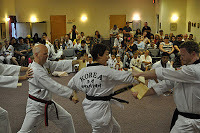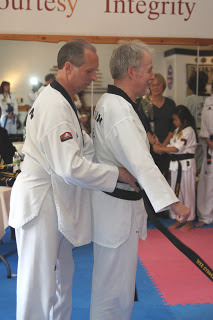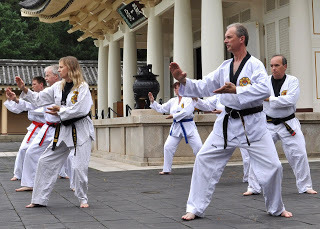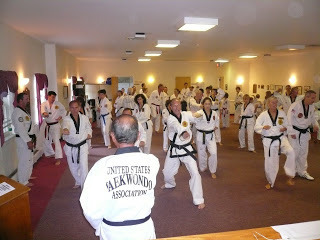Doug Cook's Blog, page 34
January 1, 2012
Chosun e-newsletter archive Volumn 3 #1 January, 2012
14th Annual Awards Banquet and Dinner Dance
Honoring Grandmaster Richard Chun December 10, 2011
 Grandmaster Richard Chun, Mrs. Chun
Grandmaster Richard Chun, Mrs. Chun
& USTA Grandmasters and MastersA TAEKWONDO NIGHT TO REMEMBER!
Members of the United States Tae Kwon Do Association and the Chosun Taekwondo Academy, paid a long-overdue tribute to Grandmaster Richard Chun on a recent December evening in the midst of the holiday season. In attendance were over 200 students and masters who happily traveled many miles to participate in the historic event. One of the many highlights of the evening was a retrospective of Grandmaster Chun's life thus far produced by Chosun Black Belts, Mary Sudul and Laura LoForese. The festivities continued with the annual Chosun Taekwondo Academy awards presentation.
Kyosanims Pamela Pyke and Klye Roeloffs were the recipients of the 2011 Student of the Year award. Congratulations to all 2011 Chosun Taekwondo Academy award winners!
Read entire newsletter

Honoring Grandmaster Richard Chun December 10, 2011
 Grandmaster Richard Chun, Mrs. Chun
Grandmaster Richard Chun, Mrs. Chun & USTA Grandmasters and MastersA TAEKWONDO NIGHT TO REMEMBER!
Members of the United States Tae Kwon Do Association and the Chosun Taekwondo Academy, paid a long-overdue tribute to Grandmaster Richard Chun on a recent December evening in the midst of the holiday season. In attendance were over 200 students and masters who happily traveled many miles to participate in the historic event. One of the many highlights of the evening was a retrospective of Grandmaster Chun's life thus far produced by Chosun Black Belts, Mary Sudul and Laura LoForese. The festivities continued with the annual Chosun Taekwondo Academy awards presentation.
Kyosanims Pamela Pyke and Klye Roeloffs were the recipients of the 2011 Student of the Year award. Congratulations to all 2011 Chosun Taekwondo Academy award winners!
Read entire newsletter
Published on January 01, 2012 14:40
December 1, 2011
Chosun e-newsletter archive volumn 2 #12, 2011
Dear Martial Arts Entusiast,
Welcome to the December, 2011 edition of the Chosun newsletter.
Master Cook awarded first place in essay contest hosted by the Embassy of the Republic of Korea November, 2011
 Master Cook's essay, The Evolution of Taekwondo Poomsae, Hyung and Tul, won first place in a nationwide search hosted by the Korean Embassy for exceptional writing and artwork that capture the unique personal experiences and spirit of Taekwondo, Korea's own martial art. Now in its third year, the essay contest has been a key embassy program for promoting and reaffirming the special bond between the United States and the Republic of Korea by bringing together people from diverse backgrounds with a common passion. Master Cook will attend an awards ceremony that will take place at the embassy's Korean Cultural Center in Washington DC , where Ambassador Han Duk-soo will present certificates to prizewinners.
Read entire newsletter
Master Cook's essay, The Evolution of Taekwondo Poomsae, Hyung and Tul, won first place in a nationwide search hosted by the Korean Embassy for exceptional writing and artwork that capture the unique personal experiences and spirit of Taekwondo, Korea's own martial art. Now in its third year, the essay contest has been a key embassy program for promoting and reaffirming the special bond between the United States and the Republic of Korea by bringing together people from diverse backgrounds with a common passion. Master Cook will attend an awards ceremony that will take place at the embassy's Korean Cultural Center in Washington DC , where Ambassador Han Duk-soo will present certificates to prizewinners.
Read entire newsletter

Welcome to the December, 2011 edition of the Chosun newsletter.
Master Cook awarded first place in essay contest hosted by the Embassy of the Republic of Korea November, 2011
 Master Cook's essay, The Evolution of Taekwondo Poomsae, Hyung and Tul, won first place in a nationwide search hosted by the Korean Embassy for exceptional writing and artwork that capture the unique personal experiences and spirit of Taekwondo, Korea's own martial art. Now in its third year, the essay contest has been a key embassy program for promoting and reaffirming the special bond between the United States and the Republic of Korea by bringing together people from diverse backgrounds with a common passion. Master Cook will attend an awards ceremony that will take place at the embassy's Korean Cultural Center in Washington DC , where Ambassador Han Duk-soo will present certificates to prizewinners.
Read entire newsletter
Master Cook's essay, The Evolution of Taekwondo Poomsae, Hyung and Tul, won first place in a nationwide search hosted by the Korean Embassy for exceptional writing and artwork that capture the unique personal experiences and spirit of Taekwondo, Korea's own martial art. Now in its third year, the essay contest has been a key embassy program for promoting and reaffirming the special bond between the United States and the Republic of Korea by bringing together people from diverse backgrounds with a common passion. Master Cook will attend an awards ceremony that will take place at the embassy's Korean Cultural Center in Washington DC , where Ambassador Han Duk-soo will present certificates to prizewinners.
Read entire newsletter
Published on December 01, 2011 12:24
November 3, 2011
TaeKwonDo Times Traditions Column by Master Doug Cook-November, 2011

The Promotion Process
Approaching a Belt Test with Enthusiasm and Passion
Six months ago, I had the supreme honor of testing for my 6th dan black belt at an examination officiated by martial arts legend, Grandmaster Richard Chun. Looking back, the first time I stumbled into Kwanjangnim's world was as a newly-minted yellow belt when I first read his always inspiring book Tae Kwon Do: The Korean Martial Art. Since then, I have trained under this man and his instructors for many, many years. And so, it was a distinct privilege to perform before him on a pleasant, spring day last June.
I have always been excited about the prospect of testing. I approach these events, now long in between, with great anticipation and when the welcomed day finally arrives, I do my utmost to exhibit enthusiasm, precise technique and authentic martial spirit. I always treat the process as a celebration of my hard-earned skills rather than with the apparent stress that characterizes a typical test in its truest sense.
Still, not everyone agrees with this outlook. Many view a belt test, especially impatient parents, as an imposition of significant proportions. Why not simply present the student with a new belt during class when the instructor deems them ready? Why consume four or five hours out of a weekend, usually four times a year, when the average individual can barely find the time to attend weekly classes? Naturally, there are pros and cons to any process of this nature. Yet, depending on how the event is administrated, to most students of the traditional martial arts, the benefits far outweigh any inconveniences that might materialize.
Read entire column
Published on November 03, 2011 14:44
TaeKwonDo Times Traditions Column by Master Doug Cook - September, 2011

One Divorce Too Many
The Loss of a Black Belt Student Can be a Disheartening Experience
One spring day in 1997, just before beginning a vigorous training session at the Richard Chun Taekwondo Center in New York City, I sat with Grandmaster Chun in his office discussing several issues relating to school ownership. Being the benevolent and forthcoming man that he is, Grandmaster Chun was never one to hold back valuable information from his disciples.
The conversation on that warm afternoon centered on my question as to why he chose not to display photographs of his many black belt students on the walls of his Upper Eastside dojang. The root of my query evolved from observations I had made while visiting various schools here and in Korea, the homeland of tae kwon do. At one dojang locally, I had noticed a cluster of color photos depicting what appeared to be the location's entire population of black belts; there wasn't many, but they all seemed to be represented, including the master instructor. Likewise, while training at the Korean National University for Physical Education or KNUPE, in Seoul, South Korea, as well as other noteworthy training facilities in the "land of the morning calm", I was impressed with row upon row of proud, young black belts frozen in black and white images that stared down at me from frames firmly secured above the mirrors that ran the entire length of the dojang. Tributes of this sort seemed to add an air of heritage and permanence to not only the institution itself, but also the sacred training floor upon which we were about to stand. And so, almost two decades ago, shrouded in my naiveté', I was confounded as to why my kwanjangnim did not share in this practice.
Without ever meeting Grandmaster Chun, one could not be familiar with his humble, gracious demeanor. He is unyieldingly courteous and disarmingly kind in his approach; except, of course, when he is standing in class before a large group of students. It is then that his ferocity and passion for tae kwon do quickly becomes apparent. Nevertheless, sitting at his desk across from me that day, he paused seemingly in deep reflection before answering. I trust that I am not breaking a confidence when I share his reply. Kwanjangnim looked up and said "If I were to mount photos of every black belt that I have graduated across the years at this school alone, not only would they fill every available wall, but a real danger exists that I would weep for those who have left." With that statement, I truly began to understand the deep and singular relationship that exists between a worthy master and his loyal students.
Read entire column
Published on November 03, 2011 14:12
TaeKwonDo Times Column Traditions by Master Doug Cook - September, 2011

One Divorce Too Many
The Loss of a Black Belt Student Can be a Disheartening Experience
One spring day in 1997, just before beginning a vigorous training session at the Richard Chun Taekwondo Center in New York City, I sat with Grandmaster Chun in his office discussing several issues relating to school ownership. Being the benevolent and forthcoming man that he is, Grandmaster Chun was never one to hold back valuable information from his disciples.
The conversation on that warm afternoon centered on my question as to why he chose not to display photographs of his many black belt students on the walls of his Upper Eastside dojang. The root of my query evolved from observations I had made while visiting various schools here and in Korea, the homeland of tae kwon do. At one dojang locally, I had noticed a cluster of color photos depicting what appeared to be the location's entire population of black belts; there wasn't many, but they all seemed to be represented, including the master instructor. Likewise, while training at the Korean National University for Physical Education or KNUPE, in Seoul, South Korea, as well as other noteworthy training facilities in the "land of the morning calm", I was impressed with row upon row of proud, young black belts frozen in black and white images that stared down at me from frames firmly secured above the mirrors that ran the entire length of the dojang. Tributes of this sort seemed to add an air of heritage and permanence to not only the institution itself, but also the sacred training floor upon which we were about to stand. And so, almost two decades ago, shrouded in my naiveté', I was confounded as to why my kwanjangnim did not share in this practice.
Without ever meeting Grandmaster Chun, one could not be familiar with his humble, gracious demeanor. He is unyieldingly courteous and disarmingly kind in his approach; except, of course, when he is standing in class before a large group of students. It is then that his ferocity and passion for tae kwon do quickly becomes apparent. Nevertheless, sitting at his desk across from me that day, he paused seemingly in deep reflection before answering. I trust that I am not breaking a confidence when I share his reply. Kwanjangnim looked up and said "If I were to mount photos of every black belt that I have graduated across the years at this school alone, not only would they fill every available wall, but a real danger exists that I would weep for those who have left." With that statement, I truly began to understand the deep and singular relationship that exists between a worthy master and his loyal students.
Read entire column
Published on November 03, 2011 14:12
The Evolution of Tae Kwon Do Poomse, Hyung and Tul

Long before the advent of sport sparring and the invention of modern safety gear, in a time when to fight meant to defend one's life from almost certain death an ingenious method of transmitting martial arts skills from venerated master to loyal disciple was developed. Legend has it that experienced warriors returning unscathed from combat, a testimony in and of itself to their martial prowess, mimicked techniques used to vanquish opponents on the field of battle for the benefit of those less qualified in the ways of war. This ritual may have been practiced around a campfire, in secret gardens or in the incense-filled halls of ancient Buddhist temples lending credence to the notion that the dynamic practice of formal exercises has existed for centuries. Several examples demonstrating this concept can be traced back to antiquity with roots found in primitive works of art and ancient yogic postures originally intended to promote health and core strength in sedentary clerics.
Today, poomsae, hyung or tul - all culturally-specific terms for Korean martial arts patterns - can be defined as choreographed sequences of techniques aimed at defeating multiple attackers originating from various directions. They can also be thought of as "quality shapes of strength" representing the comprehensive catalog of Traditional and Kukki Tae Kwon Do skills. Moreover, poomsae demonstratively symbolize the essence of the art and can be distilled down into two discrete categories – those created in modern times as opposed to those tracing their pedigree to primordial practices.
In an effort to quantify the significance of this division, we must first appreciate that the formal exercises found in Tae Kwon Do today were not created in a vacuum. Rather, an analysis of the historical evidence at hand reveals that empty-hand fighting arts, in conjunction with their associated formal exercises, developed naturally across continents as various cultures adapted to cope with the dangers posed by increased trade and human aggression accompanied by imperialist desire. Still, the need to practice prearranged chains of combat tactics in a relatively relaxed environment devoid of mayhem and death was apparently universal.
In his book, Moving Zen, Shotokan karate-do practitioner C.W. Nicol describes forms practice as "a dynamic dance; a battle without bloodshed or vanquished." He further goes on to say that, "we are somehow touching the warrior ancestry of all humanity" and that "of all the training in karate, none is more vigorous, demanding or exhilarating than the sincere performance of kata." From this we can see that poomsae training, if approached in a traditional manner, not only cultivates defensive and offensive proficiency coupled with ki (internal energy) development, but establishes a profound link with masters of the past who clearly did not perform formal exercises merely for physical fitness as some would claim, but as a means of collating hard-earned martial skills often fostered on the field of battle or in the supercharged atmosphere of some distant training hall, for the benefits of students across the centuries.
Read entire article
Published on November 03, 2011 11:01
November 2, 2011
Chosun e-newsletter archive Volumn 2 #11 November, 2011
Dear Martial Arts Enthusiast,
Welcome to the November edition of the Chosun newsletter. The Chosun Taekwondo Academy wants to extend and invitation to you and your family to attend our:
14th Annual Awards Banquet & Dinner Dance
Saturday December 10th, 2011 6:30 - 11:00 pm
Black Bear Golf Club, 138 Route 23 North, Franklin, NJ 07416
DJ and dancing, cash bar, awards presentation, and a visit from Santa!
Adults: $49 / Children:$39 / under 4 years: FREE Make checks payable to Chosun Taekwondo Academy. Remit to Chosun Taekwondo Academy PO Box 721 Warwick, NY 10990
Reserved seating available: contact Chosun at info@chosuntkd.com
Kamsahamnida,
Patty Cook, Editor
Read entire newsletter
Welcome to the November edition of the Chosun newsletter. The Chosun Taekwondo Academy wants to extend and invitation to you and your family to attend our:
14th Annual Awards Banquet & Dinner Dance
Saturday December 10th, 2011 6:30 - 11:00 pm
Black Bear Golf Club, 138 Route 23 North, Franklin, NJ 07416
DJ and dancing, cash bar, awards presentation, and a visit from Santa!
Adults: $49 / Children:$39 / under 4 years: FREE Make checks payable to Chosun Taekwondo Academy. Remit to Chosun Taekwondo Academy PO Box 721 Warwick, NY 10990
Reserved seating available: contact Chosun at info@chosuntkd.com
Kamsahamnida,
Patty Cook, Editor
Read entire newsletter
Published on November 02, 2011 14:54
October 12, 2011
An Interview with Master Doug Cook - Instructor, Author and Supporter of Traditional Taekwondo

The I Ching or Book of Changes is an ancient Taoist classic. From it we learn that "everything happens in its appointed time." Master Doug Cook, 6th Dan Black Belt, school owner, author and regular contributor to Totally TaeKwonDo couldn't agree more. Where most practitioners begin their journey through the martial arts in their adolescent years, Master Cook began his training in his late thirties; and, if you ask him, he will confirm that the time was right.
Read the entire interview on page 19, issue #32
Published on October 12, 2011 13:36
September 30, 2011
Chosun e-newsletter archive Volumn 2 #10 October, 2011
Welcome to the October edition of the Chosun newsletter. It's hard to believe that it has been a year since the first installment of the Chosun e-newsletter. As a school, we can look back with pride and gratitude for the many accomplishments and milestones attained by the students of Chosun. In this spirit of celebration, please don't forget to MARK YOUR CALENDAR for Saturday December 10th for the 14th Annual Awards Banquet and Dinner Dance. Details below. It is a wonderful time to enjoy the season with your Chosun family. If you have missed any of the previous Chosun Newsletters, they are archived in Master Cook's Blog, The Chosun Journal on the Chosun website.
Read entire newsletter
Kamsahamnida,
Patty Cook, Editor
Read entire newsletter
Kamsahamnida,
Patty Cook, Editor
Published on September 30, 2011 14:55
September 13, 2011
ONE DIVORCE TOO MANY...The loss of a black belt without closure can be a heart-wrenching experience

One spring day in 1997, just before beginning a vigorous training session at the Richard Chun Taekwondo Center in New York City, I sat with Grandmaster Chun in his office discussing several issues relating to school ownership. Being the benevolent and forthcoming man that he is, Grandmaster Chun was never one to hold back valuable information from his disciples.
The conversation on that warm afternoon centered on my question as to why he chose not to display photographs of his many black belt students on the walls of his Upper Eastside dojang. The root of my query evolved from observations I had made while visiting various schools here and in Korea, the homeland of tae kwon do. At one dojang locally, I had noticed a cluster of color photos depicting what appeared to be the location's entire population of black belts; there wasn't many, but they all seemed to be represented, including the master instructor. Likewise, while training at the Korean National University for Physical Education or KNUPE, in Seoul, South Korea, as well as other noteworthy training facilities in the "land of the morning calm", I was impressed with row upon row of proud, young black belts frozen in black and white images that stared down at me from frames firmly secured above the mirrors that ran the entire length of the dojang. Tributes of this sort seemed to add an air of heritage and permanence to not only the institution itself, but also the sacred training floor upon which we were about to stand. And so, almost two decades ago, shrouded in my naiveté', I was confounded as to why my kwanjangnim did not share in this practice.
Without ever meeting Grandmaster Chun, one could not be familiar with his humble, gracious demeanor. He is unyieldingly courteous and disarmingly kind in his approach; except, of course, when he is standing in class before a large group of students. It is then that his ferocity and passion for tae kwon do quickly becomes apparent. Nevertheless, sitting at his desk across from me that day, he paused seemingly in deep reflection before answering. I trust that I am not breaking a confidence when I share his reply. Kwanjangnim looked up and said "If I were to mount photos of every black belt that I have graduated across the years at this school alone, not only would they fill every available wall, but a real danger exists that I would weep for those who have left." With that statement, I truly began to understand the deep and singular relationship that exists between a worthy master and his loyal students.
Since then, I too have created many black belts; clearly not as many as Grandmaster Chun, but the quantity reaches well into the hundreds. Some, based on limited tenure are difficult to remember. The vast majority, however, will never leave my mind. Many are still with me and have gone on to become highly competent master instructors. Others, having enrolled as youngsters, eventually entered college, had families of their own and relocated. A very few, sadly, have been forced to discontinue their training due to unrelated injuries or physical disabilities. But as with most martial arts schools many black belts tend to depart largely based on time constraints, family responsibilities or simple boredom stemming from a limited curriculum. This last malady frequently results in a trickling away of enthusiasm for the art in general. Fortunately, our school offers a traditional curriculum extending through 6th dan that constantly challenges the black belt, invariably igniting continuing interest. Still, to surrender for any reason is a tragedy of considerable proportions.
Regardless, the rapport that exists between the master instructor and the black belt student is exceptional in nature. If taken seriously and allowed to mature, the relationship is infused with a quantifiable consistency that mirrors other vivid liaisons in life. For example, at the culmination of the black belt examination, the master instructor symbolically bestows the student with wisdom by first wrapping the black belt around his waist before tying it around the student's. Consequently, even though the practitioner may in the future train with other instructors, this is a statement that clearly says: "I am your first master and we are tied together for now and forever." This ritual is vaguely reminiscent of another, equally heavy with meaning: that found in the bond of marriage signified by the gold wedding band. Once a serious commitment is made to the study of traditional tae kwon do, one cannot simply ignore its profound implications.
It is said that genuinely competent martial arts instructors give a little piece of themselves away to each student they seek to inspire until, eventually, there is nothing left. The only way the teacher can replenish their skill is through constant, personal training and then facing new students yet again. And so, the cycle continues. I absolutely believe this to be true. Yet I ultimately hold that it is with each defection or departure of a black belt that an intangible, spiritual fragment of the master is torn away, never again to be replaced. The silent torment, unique to those at the top, cannot rightfully be shared and is overwhelmingly exacerbated by an informal exit. Tae kwon do training is built on a platform of courage, courtesy and dignity. Accordingly, if the day should arrive when the black belt chooses to depart, it is with the above virtues in mind that their intentions should be announced in the presence of their master and not through an email, phone call or written correspondence. Without dignified closure, the matter will continue to float between the two like a dark cloud that refuses to dissipate. One can only compare the divisive nature of this separation to a painful divorce from a beloved partner and if the parties involved, or at least one, are resistant to the measure, the wound seldom heals. To the uninitiated it may appear that I am overstating my case. Yet I'd wager that having experienced the loss of several valued, once-eager black belts, most masters would tell you that each exodus feels like one divorce too many.
Tae Kwon do does not speak to everyone equally and even for those dedicated few, priorities change and difficult life decisions must be made. So, if you find yourself in the untenable position of having to sever ties with your school and master, for whatever reason, do it face-to-face with a courteous, courageous and dignified state of mind.
Published on September 13, 2011 17:33



